Kathy Lynn Emerson's Blog, page 41
June 15, 2017
GO WEST, WOMAN, GO WEST
Susan Vaughan here. In April the hubby and I spent ten days in Arizona. We hadn’t been out West in several years, so my friend and fellow author Linda Style’s invitation was a great opportunity to escape the forty-five rain-soaked degrees in Maine. What I didn’t expect in Arizona was to run across so many Maine connections. Linda and Chuck showed us the best hikes and sightseeing around Phoenix, some of which we wouldn’t have found on our own. On my bucket list was seeing the desert in bloom, and we hit it just right. One of my favorite days was spent at the Phoenix Desert Botanical Garden, where we were surrounded by cactuses in full flower. Both plurals—cacti and cactuses—are correct, for you grammar hounds. The garden boasts many saguaro cactuses, a protected plant in the state. The saguaro grows only in the Sonoran Desert, and it can take up to seventy or a hundred years before a saguaro grows its first “arm.”
Linda and Chuck showed us the best hikes and sightseeing around Phoenix, some of which we wouldn’t have found on our own. On my bucket list was seeing the desert in bloom, and we hit it just right. One of my favorite days was spent at the Phoenix Desert Botanical Garden, where we were surrounded by cactuses in full flower. Both plurals—cacti and cactuses—are correct, for you grammar hounds. The garden boasts many saguaro cactuses, a protected plant in the state. The saguaro grows only in the Sonoran Desert, and it can take up to seventy or a hundred years before a saguaro grows its first “arm.” We saw none with flowers at the top, maybe because the season was advance or because a saguaro doesn’t begin to produce flowers unit it is thirty-five or more years old. Harming a saguaro in any way leads to huge fines in Arizona.
We saw none with flowers at the top, maybe because the season was advance or because a saguaro doesn’t begin to produce flowers unit it is thirty-five or more years old. Harming a saguaro in any way leads to huge fines in Arizona.
 We chanced upon Arizona’s state tree, the palo verde, Spanish for green stick, also in bloom. The palo verde has chlorophyll in its bark, thus the green stick moniker. Throughout the weeks we saw many of these. I snapped photos of ocotillo cactus with spindly branches and bright red flowers, low-growing clumps of hedgehog cactus, and prickly pears with pinkish-orange flowers that locals make into jelly. And the Maine connection? The clerk in the garden’s gift shop saw my LL Bean card and announced that she grew up in Boothbay Harbor. She added that she missed Maine summers but not the winters.
We chanced upon Arizona’s state tree, the palo verde, Spanish for green stick, also in bloom. The palo verde has chlorophyll in its bark, thus the green stick moniker. Throughout the weeks we saw many of these. I snapped photos of ocotillo cactus with spindly branches and bright red flowers, low-growing clumps of hedgehog cactus, and prickly pears with pinkish-orange flowers that locals make into jelly. And the Maine connection? The clerk in the garden’s gift shop saw my LL Bean card and announced that she grew up in Boothbay Harbor. She added that she missed Maine summers but not the winters. 
An outing with Chuck and Linda took us to the Dolly Steamboat on Canyon Lake, which is so unlike any of our lakes in the East. The lake is literally in a canyon, in the middle of the desert, surrounded by bluffs and cliffs and craggy rocks. We managed to snag a table in the bow and munched popcorn while the captain described the various rock formations and pointed out wildlife. We saw bighorn sheep on a high bluff and moving bumps on a rock tower that he said were baby bald eagles. My simple Nikon couldn’t capture either very well.
The lake is literally in a canyon, in the middle of the desert, surrounded by bluffs and cliffs and craggy rocks. We managed to snag a table in the bow and munched popcorn while the captain described the various rock formations and pointed out wildlife. We saw bighorn sheep on a high bluff and moving bumps on a rock tower that he said were baby bald eagles. My simple Nikon couldn’t capture either very well.
The next day the hubby and I drove north from Phoenix at 200 feet above sea level to Sedona at 4000 feet up, where it was about ten degrees cooler but no less sunny. Sedona is known for its spectacular red rock formations, red because of iron oxide in the sandstone.  The town is named for the first settler’s wife Sedona Arabella Schnebley. We stayed at the Arabella Hotel, and by coincidence I know Sedona’s granddaughter Laurie Schnebley, who is a fellow author and writing teacher. The Maine connection popped up in the hotel breakfast room. A man approached us when he spotted my husband’s Red Sox cap. This man now lives elsewhere, but grew up in the Mid-Coast area, and his brother lives in our small town.
The town is named for the first settler’s wife Sedona Arabella Schnebley. We stayed at the Arabella Hotel, and by coincidence I know Sedona’s granddaughter Laurie Schnebley, who is a fellow author and writing teacher. The Maine connection popped up in the hotel breakfast room. A man approached us when he spotted my husband’s Red Sox cap. This man now lives elsewhere, but grew up in the Mid-Coast area, and his brother lives in our small town.
 My husband wanted to squeeze in as much as possible, so we hiked morning and afternoon. I slept well every night.
My husband wanted to squeeze in as much as possible, so we hiked morning and afternoon. I slept well every night.
One wonderful hike happened because we got lost. Instead of what we intended, we found the Palatki Ruin Heritage site. The National Forest Ranger had taught in Maine at Outward Bound on Hurricane Island. The climb on rock steps took us up the cliffs on the left to cliff dwellings and pictographs that date from 1100 A.D.
 Our other favorite outing was to Soldier Pass with Red Rock Jeep Tours. Not only was the scenery spectacular (Am I overusing that word?) but also our guide entertained us with descriptions and anecdotes of the history, geology, and plant and animal life, along with some corny jokes. He was our final Maine connection. Although not from Maine, he and his wife often visit Bar Harbor to go kayaking.
Our other favorite outing was to Soldier Pass with Red Rock Jeep Tours. Not only was the scenery spectacular (Am I overusing that word?) but also our guide entertained us with descriptions and anecdotes of the history, geology, and plant and animal life, along with some corny jokes. He was our final Maine connection. Although not from Maine, he and his wife often visit Bar Harbor to go kayaking.
I hope this post hasn’t been too much of a travelogue for you, but it was fun for me to revisit my vacation. And I haven’t covered nearly all we did! If you go to Sedona, I urge you to take one of the jeep tours early in your stay so you can then enjoy the rest with knowledge of the area. I do love to travel, so does anyone have a vacation tip for me? Or questions about this trip?
June 14, 2017
Portland to Portland: You Can’t Get Here From There
 Kaitlyn Dunnett/Kathy Lynn Emerson here, writing with tongue (slightly) in cheek. Next week I’m headed for “the other Portland” to attend the semi-annual U. S. gathering of members of the Historical Novel Society. These conferences are always interesting. They are held in a different city each time—San Diego was my favorite to date, since the hotel was right across the street from the maritime museum and a wonderful assortment of ships to explore. This time, I’m excited by the prospect of visiting a city and a state I’ve never been to before.
Kaitlyn Dunnett/Kathy Lynn Emerson here, writing with tongue (slightly) in cheek. Next week I’m headed for “the other Portland” to attend the semi-annual U. S. gathering of members of the Historical Novel Society. These conferences are always interesting. They are held in a different city each time—San Diego was my favorite to date, since the hotel was right across the street from the maritime museum and a wonderful assortment of ships to explore. This time, I’m excited by the prospect of visiting a city and a state I’ve never been to before.
Aside from location, the other big draw comes in the form of pre-conference workshops. Two years ago in Denver I had the opportunity to get some hands-on practice with a variety of medieval and renaissance bladed weapons. This time around, it’s sixteenth-century (and later) firearms. Also available are events like mead tastings, historical costume competitions, and Regency dancing lessons. The major attraction, however, is the pure bliss of spending a weekend with other people addicted to history. Most of those attending write historical fiction. All of them love doing research into obscure areas of history. Oh, there are sessions on the business aspects of publishing too, but where else am I likely to run into someone else who knows the story of the woman who campaigned to keep Shakespeare’s company from setting up an indoor playhouse in the Blackfriars section of London? Or someone besides me who’s read a hefty but fascinating tome titled Religion and the Decline of Magic? I expect to be in pig heaven the whole time I’m there.
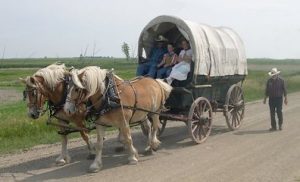 But it’s getting there and back again that’s the challenge. Once upon a time, it was possible to get a flight from Portland (Maine) to Boston and from there the rest of the world was in easy reach. No more. Aside from the time difference, which is a killer, most airlines only offer routes that take ten, twelve, or more hours to make the cross-country trip. Nothing when compared to the pioneers in covered wagons, but frustrating in this day and age. The best times are with American Airlines and even they aren’t great.
But it’s getting there and back again that’s the challenge. Once upon a time, it was possible to get a flight from Portland (Maine) to Boston and from there the rest of the world was in easy reach. No more. Aside from the time difference, which is a killer, most airlines only offer routes that take ten, twelve, or more hours to make the cross-country trip. Nothing when compared to the pioneers in covered wagons, but frustrating in this day and age. The best times are with American Airlines and even they aren’t great.
Going out, I leave PWM at 3:18 in the afternoon (after an hour and a half drive from home to the airport) and fly to Philadelphia. A little over an hour later, assuming everything is on time, I board a second plane and arrive in Portland, Oregon (PDX) at 9:18 their time (after midnight here). Not too awful, if long. A total of seven hours and 44 minutes in the air. It’s coming home that will present the greatest challenge. The best I could do (and believe me I looked at other options) was to leave PDX at 7:00 in the morning (groan!). That gets me to Chicago at 1:00 PM. So far so good. Unfortunately, my connecting flight leaves Chicago at 1:45 PM. I have a feeling it’s too much to hope at a) everything is running on time and b) the gates are right next to each other. We shall see. I am already preparing myself mentally to have to do some rebooking. Remember the good old days with regular flights between Boston and Portland? This is where I’m really going to miss that option.
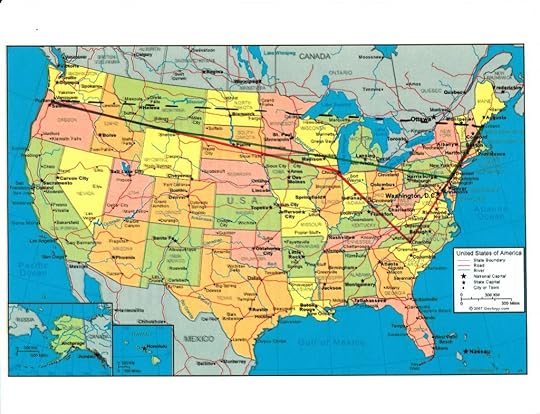
Green line is going, red line is coming home and dotted line is the route I wish they offered.
Even assuming I make my connection, the trip home doesn’t exactly take a direct route. The plane out of Chicago flies to—wait for it!—Charlotte. There, considerably south of where I want to be, I get to wait for nearly three hours before I can board a plane back to PWM. I’ll get in at 9:57 PM (and that’s in the best of all possible worlds) and still have an hour and a half drive to get home. Time in the air on the return trip? Eight hours and twenty minutes. We can only hope that’s all it takes, because on the surface it sure looks like it’s going to be a challenge to get back here from there.
Kathy Lynn Emerson/Kaitlyn Dunnett is the author of over fifty books written under several names. She won the Agatha Award for best mystery nonfiction of 2008 for How to Write Killer Historical Mysteries and was an Agatha Award finalist in 2015 in the best mystery short story category for “The Blessing Witch.” Currently she writes the contemporary Liss MacCrimmon Mysteries (Kilt at the Highland Games) as Kaitlyn and the historical Mistress Jaffrey Mysteries (Murder in a Cornish Alehouse) as Kathy. The latter series is a spin-off from her earlier “Face Down” series and is set in Elizabethan England. New in 2017 is a collection of Kathy’s short stories, Different Times, Different Crimes. Her websites are www.KaitlynDunnett.com and www.KathyLynnEmerson.com
June 13, 2017
It’s that E.B. White ode to summer time of year again
Well, it’s not even summer and it’s been 90 degrees out for two days. I’ve had enough.
But one great thing about it, is that it’s a great segue into my June tradition of wring about E.B. White’s beautiful essay, “Once More to the Lake.” I’m temporarily not living in Belgrade Lakes, the town of White’s essay and I’m also bogged down with final details of launching my new podcast (“Notes from a Cranky Editor,” check it out) and preparing my keynote speech for the Friends of Haverhill (Mass.) Public Library, which will be, um, last night when you read this.
I’m just throwing that stuff around so you don’t think I’m lying on a beach eating cheeseburgers and listening to the boom box, or whatever people who lie on the beach do.
Until this weekend, in fact, Maine’s beaches looked like this:
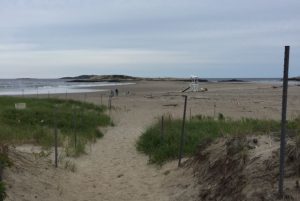
Popham Beach on June 8. C’mon, it’s not summer yet! It’s okay if it’s 50 degrees and no sun.
In any case, that’s all to say that here’s a reprise of last year’s ode to EB White, which appeared on this site, I believe, June 16, 2016:
We Maine Crime Writers live in a dark place — both geographically and mentally.
One of the things that makes Maine so delicious for mystery settings is its deep darkness. There are a lot of short days, a lot of dark hours, dead trees, bare vegetation. Lots of cold, rain, ice.
And we write about death and evil. We have to, or we wouldn’t have anything to write about as mystery writers.
But one of the great things about Maine, one of the things you don’t fully get unless you live here, is that there’s a payoff to the darkness. A day like this.
After all the gloom and gray and cold, dead trees and dead earth the state explodes into a riot of high definition greens and blues. Uncontrolled and unmanicured, warm and good-smelling. Bright and very, very alive.

The lagoon behind Ogunquit Beach at dusk, June 3.
On a day like this, it’s impossible to write anything dark, or even contemplate darkness.
As writers and readers we love the written word. One of the masters was the great E.B. White. As a child, White spent summers in Belgrade Lakes. Later in life he moved to Brooklin on the Blue Hill Peninsula and left the Lakes behind. But in 1941, he brought his 10-year-old son to Belgrade to experience the kind of summer on Great Pond he himself had as a boy.
I’m lucky enough to live in Belgrade Lakes now, and a couple years ago, after I’d moved here, I stumbled upon his beautiful essay “Once More to the Lake” about that visit with his son. I’d read it in college, but now, living here, it resonated.
Every summer, I write about E.B. and his ode to youth, growing old, mortality, the Lakes and, most of all, Maine summer. It may not be summer yet. We still have a few days until it’s official. But, boy it feels like it. And it feels good. Well, let’s let E.B. say it:
Summertime, oh summertime, pattern of life indelible,
the fade proof lake, the woods unshatterable,
the pasture with the sweet fern and the juniper forever and ever,
summer without end.

Sunset at the ferry landing on Long Island, Maine, May 27.
Maureen Milliken is the author of the Bernie O’Dea mystery series. Follow her on Twitter at@mmilliken47 and like her Facebook page at Maureen Milliken mysteries. Sign up for email updates at maureenmilliken.com. She hosts the podcast Notes from a Cranky Editor all by herself, as well Crime&Stuff with her sister Rebecca Milliken.
Beat the Heat
Jessie, in Northern New England still reeling from the swing in temperature over the past few days
 I am not sure about the rest of you but sudden changes in temperature leave me feeling adrift and lethargic. I lose the ability to plan ahead with certainty. I stumble about wondering what to wear and what to feed my family. Temperatures in the 90s in early June have left me in that regrettable state of affairs.
I am not sure about the rest of you but sudden changes in temperature leave me feeling adrift and lethargic. I lose the ability to plan ahead with certainty. I stumble about wondering what to wear and what to feed my family. Temperatures in the 90s in early June have left me in that regrettable state of affairs.
Fortunately there is one recipe I look forward to preparing even when the rest of the weather situation leaves me in misery. I hope some of you will enjoy it too. It is fast to prepare, cool to eat and should the weather suddenly turn cool again can be tossed in the freezer and used later.
Take a watermelon and chunk it up into bite sized pieces. Don’t worry about being too neat, just be thoughtful about the size of the average human mouth. Place in a bowl big enough to stir things round without too much inconvenience.
Get a hold of somewhere between 5-10 stems of mint. It needs to be fresh but the variety doesn’t really matter. Strip off the leaves and cut into thin ribbons. I prefer to use kitchen shears for this task. Mix into the melon chunks.
Now squeeze the juice out of a lime and add it to the melon. Add a couple of good sized spoonfuls of rum. Stir it all up. Give a taste and decide if you need more lime juice or more rum. If the flavors are still flat, or if the color of the melon is still a bit peaked, slosh on more of whichever or both. Stir again. Sample again. Serve to enthusiastic applause. If you have leftovers, which you probably won’t, this is great frozen or pureed and then frozen and served like a granita.
June 11, 2017
Still Finding That Magical Connection
Kate Flora here. Actually, I am across the pond, exploring the battlefields of Normandy, but I didn’t want all of you to feel neglected, so here is something from my mother. She’s been gone ten years now, but because she was a writer, and I have some of her columns, her book, From the Orange Mailbox, and her unpublished memoir, I have many chances to connect with her still, and see the world through her eyes, as she watched it from her hilltop farm in Union. The following explains how my mother came to have her giant orange cat.
Einstein is asleep inside the paper bag at my feet. An hour ago she was catnapping in the bring-in-vegetables basket. This orange fur ball seems to alternate between energetic racing, climbing and pouncing upon objects (bare feet and shoes with loose laces high on the preferred list), and suddenly sleeping. The expression “drops off to sleep” has new meaning as I watch the kitten.
This addition to my household was not intentional. I’m still saying “temporary addition.” Last year, when my nearest neighbor was adjusting to a death in the family, I told her that she must learn to ask for help, that it made people feel good when they knew there was some specific thing they could do. Then I added, “Call me if you need help.” I was ready ton lift, carry, shovel or provide transportation. I wasn’t expecting a call about kittens.
Myrtie, my neighbor, had found two kittens in her field, probably dropped there by one of those individuals who attends church every Easter, talks about good works, and thinks that kittens, like tigers and cougars and other cats, can surely take care of themselves in the wild. Or, more likely, an individual who doesn’t think.
As an animal lover, Myrtie couldn’t leave the little creatures in the field, but her two dogs regarded the kittens as unwelcome intruders, or possible dessert. A couple living on the pond took one. My granddaughter persuaded me to bring the other one home. After all, hadn’t I told Myrtie that I was ready and willing to help? A kitten would be nice to have around when the cousins, Jake and Max, arrived. Because this was such a smart kitten, it was named Einstein. We’re not sure yet whether it will be Albert or Alice. Maybe Einee. But here I am, definitely a dog person, with a fluffy, big-footed orange kitten in my house.
Over the past four decades, many cats have lived on this farm. There were barn cats and cellar cats and the children’s pets. Once they named four newborn kittens Nancy, Nancy, Nancy, and Nancy, and explained that then if you called, “Nancy,” at least one would come. They had Roy Rogers, Dale Evans, and The Sheriff. Alas Poor Yorick, Rapunzel, and Bill Keene (named for a nice man who let the children climb up and sit on his new dump truck.)
I look at Einstein’s inquisitive blue eyes and her big furry feet and think of Ogden Nash’s verse: The trouble with a kitten is THAT eventually, it becomes a CAT. Am I borrowing trouble fretting about stumbling over a cat? Growing too anxious listening to a friend describe the behavior of her ex-kitten now going through a teenage phase?
The paper bag is empty. Einstein is investigating the crawl space behind the desk and comes forth with cobwebs between her ears. I remind her that she’s a temporary addition to my household. She climbs to the top of the wing chair, curls into an orange ball, and purrs. Does that translate into, “Let’s wait and see?”
The cat outlived my mother, found a new family, and finally shuffled off its furry coil at the age of 23.
June 9, 2017
Weekend Update: June 10-11, 2017
 Next week at Maine Crime Writers, there will be posts by Kate Flora (Monday), Jessie Crockett (Tuesday), Maureen Milliken (Wednesday), Kaitlyn Dunnett/Kathy Lynn Emerson (Thursday), and Susan Vaughan (Friday).
Next week at Maine Crime Writers, there will be posts by Kate Flora (Monday), Jessie Crockett (Tuesday), Maureen Milliken (Wednesday), Kaitlyn Dunnett/Kathy Lynn Emerson (Thursday), and Susan Vaughan (Friday).
In the news department, here’s what’s happening with some of us who blog regularly at Maine Crime Writers:
from Kaitlyn Dunnett/Kathy Lynn Emerson: My two giveaways on Goodreads both end next week. Here are the links:
https://www.goodreads.com/giveaway/show/238377-scone-cold-dead https://www.goodreads.com/giveaway/show/238693-julia-s-mending
And folks who read ebooks might also want to check the other Kaitlyn Dunnett titles in the Liss MacCrimmon series. These offers are made by the publisher and change fast, but the last time I checked Amazon and iTunes, Kilt at the Highland Games was down to $2.99 and Bagpipes, Brides, and Homicides was only ninety-nine cents.
An invitation to readers of this blog: Do you have news relating to Maine, Crime, or Writing? We’d love to hear from you. Just comment below to share.
And a reminder: If your library, school, or organization is looking for a speaker, we are often available to talk about the writing process, research, where we get our ideas, and other mysteries of the business. Contact Kate Flora
June 8, 2017
A Little Miracle Here and There…
My son is spending the summer working with refugees in Amman, Jordan at a community center run by a nonprofit called the Collateral Repair Project. When I feel the need to root where he is in my thinking, I pull up a map, locate Amman and then work my way out in concentric circles. What surrounds him? What comes after that? And after that? In doing that, names I’d heard over four decades of being Catholic and being aware of strife and conflict in the Middle East, start to dance before me. The Jordan River. The Dead Sea. Galilee. And, of course, Jerusalem. My son plans to visit these places and more when he’s not working.
Perhaps with Morgan’s summer work in mind, my mother recently gave me Fr. James Martin’s Jesus: A Pilgrimage to read. [Barely has a week passed during my entire life that my mother hasn’t dropped off some articles or a book for me to read “during my spare time.” But when your mother gives you something to read, you read it.] Fr. Martin writes about visiting many of the sites that Morgan will see and being struck by the realization that the people he spent a lifetime studying actually walked these sites. These sites became real, with rocks and dirt and sea and sky. In one of many moving passages in his book, Fr. Martin visits Tabgha in Galilee, the site of the multiplication of the loaves and fishes. It’s one of the most familiar stories, where Jesus takes five loaves and two fish and feeds thousands of followers. But, as Fr. Martin baked in the furnace-like heat of Tabgha, another lesson came to him from that story, one that spoke to me, particularly in the midst of the division, anger and stress we are all feeling today.
The little boy with the loaves and fishes clearly felt that what he had was inadequate and so hesitated to offer it. Fr. Martin realized that we all feel that way, that our meager skills and gifts are often inadequate, and so we don’t offer them up. We hide them. But what we don’t know, what we can’t predict, is what impact our inadequate offerings might have on someone who needs them. A simple kind word. Reaching out to someone who seems to be withdrawing. The small things we can do, which may seem inadequate or which we may not even remember doing, can have an overwhelming effect on someone who needed that gesture or comment or connection at that particular moment. What seemed inadequate or forgettable to us could be extraordinarily important to the recipient–a drop of water in a desert.
The miracle is that things we can do, little things, things we think are inadequate or inconsequential, multiply into something transformative.
And, according to Google Maps, my son is less than three hours from Tabgha.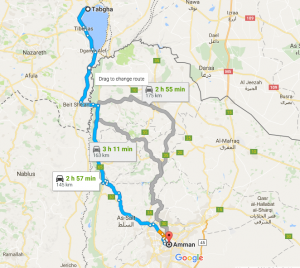
Amman to Tabgha
June 7, 2017
Why Does Sherlock Holmes Smoke a Curved Pipe?
by Barb, arriving back in Maine today
Why does he wear a deerstalker hat? Why does he say, “Elementary, my dear Watson?” None of these things appear in the canon.
The answer is these now familiar traits either originated or were popularized by American actor, writer, and stage manager William Gillette (1853-1937). I recently toured his home, Gillette Castle, in East Haddam, Connecticut.
Gillette grew up in the Nook Farm section of Hartford, Connecticut, where his neighbors included Harriet Beecher Stowe and Mark Twain. His father was a US Senator and his mother a descendant of the Puritan founder of Hartford. One of his much older brothers went off to California where he died, another was killed in the Civil War, but William’s path was different. After a short apprenticeship in New Orleans as an actor, Gillette was recommended by Twain to appear in The Gilded Age in Boston. Twain also encouraged him to write and create his own material.
Gillette did write plays and act. In his role as a stage manager he received a patent on an invention that made the sound when the horses’ hooves go clippity-clop. But he found his greatest role as Holmes. With Conan Doyle’s blessing and support, he adapted the stories for the stage and performed as the detective over 1300 times. He gave Holmes his curved pipe. The deerstalker hat had appeared in an illustration in the Strand Magazine, but Gillette popularized it. He added the phrases, “Elementary, my dear fellow,” and “my dear Watson,” separately to his scripts, but never used them together. That came later.
As his success climbed, he lived permanently aboard his yacht, the Aunt Polly, traveling to gigs up and down the east coast. A tour of England, playing Holmes, netted him $100,000, (over two million in today’s money). Those are the funds he used to build the home where he spent his retirement. (Like many good actors, he retired multiple times.)
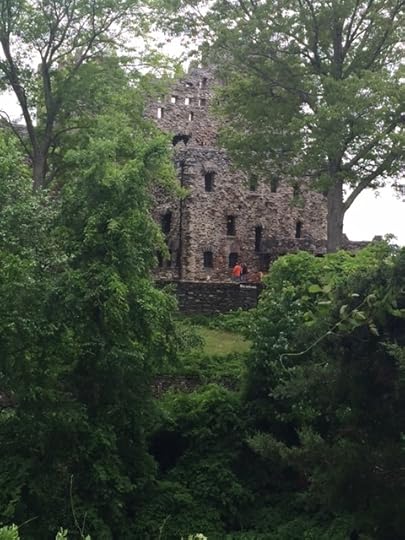
Gillette Castle
He never called his home a castle, though everyone else did. Inside it’s a sort of craftsman style with built-ins and a dining table and desk that move on gliders. You can tell the owner lived on a ship for many years. Everything has its place. He entertained many people there, including a very young Betty Davis and her mother.

The Great Hall
In retirement, Gillette continued to tinker. He built a three-mile railroad track around his property, complete with station, bridges and a tunnel and gave train rides to his guests. Down the hill from the castle, he designed an elegant small home for Yukitaki Ozaki, his longtime dresser, valet and friend. (Except when Izaki’s wealthy family, descended from Japanese nobility, came to America. Because Izaki feared they’d never understand why their son worked as a servant, Gillette worked as his butler’s butler during their visit.)
[image error]
The green bedroom. Gillette was a cat lover who always had 15 to 20 around the estate.
Gillette made a silent movie of one of his Holmes performances in 1916 that was thought lost for decades until it was rediscovered in 2014 at the at the Cinematheque Francaise, a film archive in Paris.
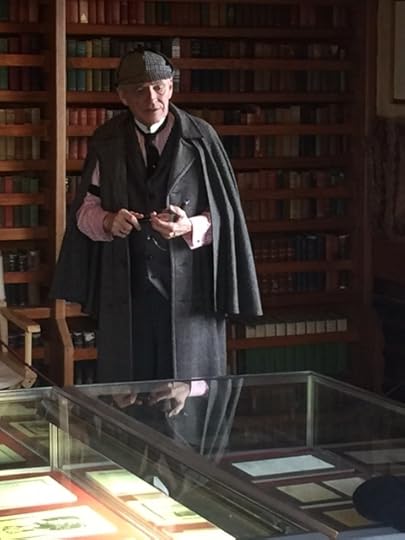
In the library, one of the guides, acting as Gillette, acting as Holmes.
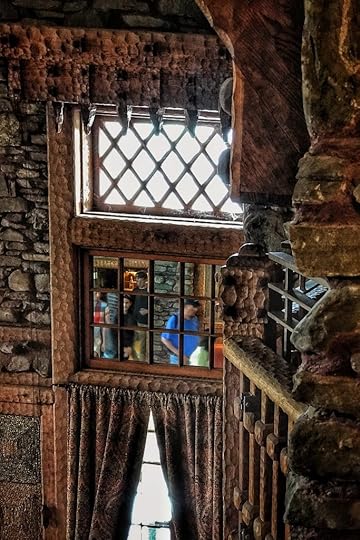
Gillette used the mirrors over the transoms in the Great Hall to check from his bedroom who was at the front door, and to see which of his guests was hanging around the bar, which could only be opened by him.
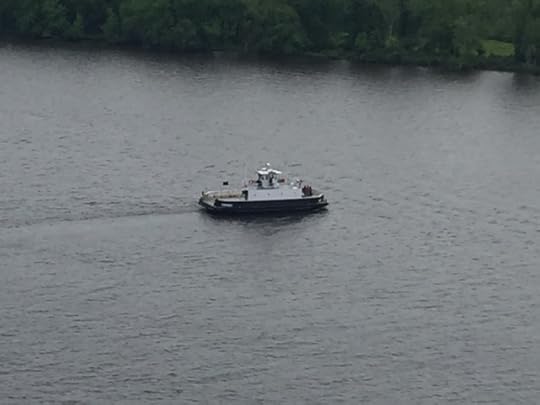
The ferry from Chester to Hadlyme which docks right below the estate.
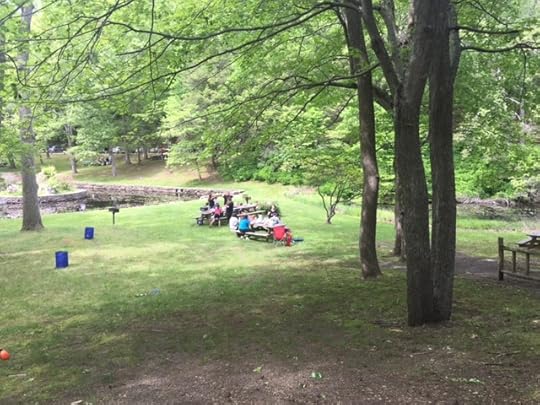
Families enjoying Memorial Day weekend picnics on the grounds.
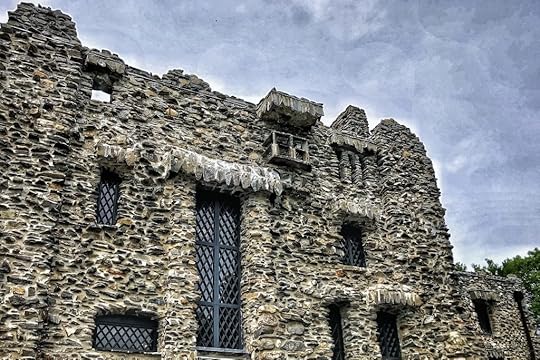
I very much enjoyed touring Gillette’s home and picnicking on the grounds of his estate. I felt that unbroken line from Gillette to Basil Rathbone to Jeremy Brett and onward to Robert Downey, Jr, Benedict Cumberbatch, and Jonny Lee Miller, in that most enduring of detective roles.
Visit if you get a chance. Check the website for opening and tour times. http://www.ct.gov/deep/cwp/view.asp?a=2716&q=325204&deepNav_GID=1650%20
Save
Save
Save
Save
Save
Save
June 6, 2017
How I Smuggled Drugs into Calcutta
Lea Wait, here. And, yes, I did that. Do note: although they were illegal for me to bring with me, the drugs included aspirin, vitamins, medications for scabies and other skin infections, and antibiotics. I also took children’s tape recorders, incubator parts, balloons, hair elastic and barrettes, children’s underwear and an assortment of other gifts for clinics and orphanages and missions.
All these goods were illegal because they had not been manufactured in India. It was October of 1985. India was focused on self-sufficiency and developing its own industries. Nothing manufactured in India could be imported. But domestic goods were expensive, and the organizations I was going to visit had very little money. (I also brought money to buy a refrigerator that could be used for medications — something one of the child welfare organizations I was working with couldn’t afford.)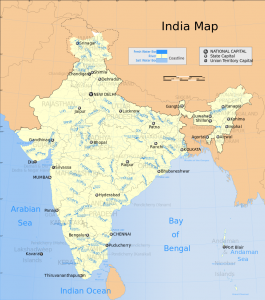
Why was I going to Calcutta (now Kolkata)? To meet and bring home Purnima, an almost-ten-year-old girl I was going to adopt, and, I hoped, at least one other child waiting to travel to the United States. The supplies I was bringing were donations from me and other single adoptive parents.
I’d collected them (speaking to groups, calling friends who were doctors, asking companies to donate) for about six months. In total, in addition to one large “pocketbook” (one of my daughters called it “Mom’s big ugly red bag”) which held paperwork and the only personal clothing and toiletries I was taking with me and could carry on board, I had three very large vertical duffle bags on wheels. Every day my three daughters at home and I removed any packaging from donated or purchased items (to save space) and crammed the supplies into the large bags. They expanded as the days grew closer to my departure.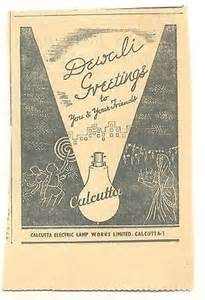
I wrote to Air India, explaining what I was doing (“bringing supplies for orphanages”) and asked for a baggage weight waver. They agreed.
When my children and two adoptive parent friends dropped me at Kennedy Airport in New York I had a four page single-spaced list of what was in the bags I was checking (tape recorders became “music machines,” and so forth), my ugly red bag was over my shoulder, and I had over twelve hundred pounds of luggage. While people around me were having boxes inspected before being checked in (four months before this an Air India flight had been the taken down by a bomb, and airline security was high,) my duffle bags were zipped open, given a cursory, horrified glance, and then checked. The letter from the president of Air India was successful.
About twenty hours later, at three a.m., we landed in Bombay (now Mombai), where I had an eighteen hour layover before taking an Indian Air flight to Calcutta. I had been told the airline would arrange for a hotel room for me.
After waking up the man behind the Air India counter I was told that there was no room — unless I was a first class passenger. I wasn’t. When I pleaded for help, the clerk went outside the terminal, woke up several people sleeping in a bus with broken windows and torn seats, shooed them away, and told the driver to take me to a hotel he had called.
We sped past people sleeping in and alongside the streets in the middle of the night. Finally we stopped at a small building where I checked in and was given a room key. My large bags, which had been checked through to Calcutta, were still at the airport, and that made me nervous. I stepped over people sleeping in the halls of the small hotel and found my room. A mattress was on the floor, the toilet was a hole in the floor, and one faucet supplied water. At some point it occurred to me that no one in the world knew where I was. I wasn’t sure myself.
I didn’t sleep much. I kept worrying about everything in the bags left at the airport. After several hours I checked out and asked for a taxi to take me back to the airport. I spent the day there, watching my luggage (which was in an open area,) reading, and then speaking with a young Iranian woman who saw my books and was eager to practice her English. While her husband glowered at us, we chatted about being parents, living in a city being bombed (her,) and adopting children (me.) When we parted I gave her two of the paperbacks I’d brought so she could read them. We exchanged addresses, but she said no mail would be delivered to her, and she doubted she would be able to get a letter to me.
As she predicted, I never heard from her again.
Finally that evening my flight to Calcutta took off. To ensure that the luggage checked belonged to passengers on the flight, each passenger had to identify their bags at the foot of the steps to the plane, and their identity had to be verified.
Three hours later, at about midnight, the flight landed in Calcutta. It was Diwali — a major festival — and fireworks filled the air. I was the last person off the plane. I didn’t expect to see the uniformed soldiers with machine guns stationed at the foot of the steps and throughout the terminal.
I’d been told by contacts in Calcutta to collect my bags, and then try to get them through customs and security. If I had any problems, I was told to invoke Mother Theresa’s name … but only in desperation. She did not normally accept donations like mine, and that was well-known.
By the time I got my bags and maneuvered them, (thank goodness for wheels) to the customs agent (it never occurred to me why they were checked here, and not in Mombai) the agent in charge was clearly ready to leave and party. I handed him the list of what I’d brought. He glanced at it. Then he opened the top of one bag — stuffed with balloons and underwear and combs and unidentifiable items. “All like this?” he gestured to my bags.
“Yes.” I said. He shook his head, clearly not prepared to check every item, and gestured that I should proceed.
Immediately, three men ran in from the outside of the terminal, grabbed my bags, and headed toward a waiting car. I crossed my fingers that they were people I could trust, and ran after them. Within couple of minutes we were on the road to Calcutta, passing celebrants and lights, on the way to my hotel.
I stayed in Calcutta and other cities in West Bengal for ten days. Every day was an adventure. Everything in my bags found homes, although there were complications of various sorts.
I met my daughter, and another child I would bring back to America with me.
I learned a lot about India.
And perhaps I’ll write about all of that in a future blog.
But for me, arriving safely with the supplies I’d brought was a major success — and relief.
After that, the next part of the story could begin.
Smuggling Drugs into Calcutta
Lea Wait, here. And, yes, I did that. Do note: although they were illegal for me to bring with me, the drugs included aspirin, vitamins, medications for scabies and other skin infections, and antibiotics. I also took children’s tape recorders, incubator parts, balloons, hair elastic and barrettes, children’s underwear and an assortment of other gifts for clinics and orphanages and missions.
All these good were illegal because they had not been manufactured in India. It was October of 1985. India was focused on self-sufficiency and developing its own industries. Nothing manufactured in India could be imported. But domestic goods were expensive, and the organizations I was going to visit had very little money. (I also brought money to buy a refrigerator that could be used for medications — something one of the child welfare organizations I was working with couldn’t afford.)
Why was I going to Calcutta (now Kolkata)? To meet and bring home Purnima, an almost-ten-year-old girl I was going to adopt, and, I hoped, at least one other child waiting to travel to the United States. The supplies I was bringing were donations from me and from other single adoptive parents.
I’d collected them (speaking to groups, calling friends who were doctors, asking companies to donate) for about six months. In total, in addition to one large “pocketbook” (one of my daughters called it “Mom’s big ugly red bag”) which held paperwork and the only clothing and toiletries I was taking with me and could carry on board, I had three very large vertical duffle bags on wheels. Every day my three daughters at home and I removed any packaging from donated or purchased items (to save space) and crammed the supplies into the large bags. They expanded as the days grew closer to my departure.
I wrote to Air India, explaining what I was doing (“brining supplies for orphanages”)and asked for a baggage weight waver. They agreed.
When my children and two adoptive parent friends dropped me at Kennedy Airport in New York I had a four page single-spaced list of what was in the bags I was checking (tape recorders became “music machines,” and so forth), my ugly red bag was over my shoulder, and I had over twelve hundred pounds of luggage. While people around me were having boxes inspected before being checked (four months before an Air India flight had been the taken down by a bomb, and airline security was high,) my duffle bags were zipped open, given a cursory, horrified glance, and then checked. The letter from the president of Air India letter was successful.
About twenty hours later, at three a.m., we landed in Bombay (now Mombai), where I had an eighteen hour layover before taking an Indian Air flight to Calcutta. I had been told the airline would arrange for a hotel room for me.
After waking up the man behind the Air India counter I was told that there was no room — unless I was a first class passenger. I wasn’t. When I pleaded for help, the clerk went outside the terminal, woke up several people sleeping in a bus with broken windows and torn seats, shooed them away, and told the driver to take me to a hotel he had called.
We sped past people sleeping in and alongside the streets in the middle of the night. Finally we stopped at a small building where I checked in and was given a room key. My large bags, which had been checked through to Calcutta, were still at the airport, and that made me nervous. I stepped over people sleeping in the halls of the small hotel and found my room. A mattress was on the floor, the toilet was a hole in the floor, and one faucet supplied water. At some point it occurred to me that no one in the world knew where I was. I wasn’t sure myself.
I didn’t sleep much. I kept worrying about everything in the bags left at the airport. After several hours I checked out and asked for a taxi to take me back to the airport. I spent the day there, watching my luggage (which was in an open area,) reading, and then speaking with a young Iranian woman who saw my books and was eager to practice her English. While her husband glowered at us, we chatted about being parents, living in a city being bombed (her,) and adopting children (me.) When we parted I gave her two of the paperbacks I’d brought so she could read them. We exchanged addresses, but she said no mail would be delivered to her, and she doubted she would be able to get a letter to me.
As she predicted, I never heard from her again.
Finally that evening my flight to Calcutta took off. To ensure that the luggage checked belonged to passengers on the flight, each passenger had to identify their bags at the foot of the steps to the plane, and their identity had to be verified.
Three hours later, at about midnight, the flight landed in Calcutta. It was Diwali — a major festival — and fireworks filled the air. I was the last person off the plane. I didn’t expect to see the uniformed soldiers with machine guns who were stationed at the foot of the steps and throughout the terminal.
I’d been told by contacts in Calcutta to collect my bags, and then try to get them through customs and security. If I had any problems, I was told to invoke Mother Theresa’s name … but only in desperation. She did not normally accept donations like mine, and that was well-known.
By the time I got my bags and maneuvered them, (thank goodness for wheels) to the customs agent (it never occurred to me why they were checked here, and not in Mombai) the agent in charge was clearly ready to leave and party. I handed him the list of what I’d brought, which he glanced at. Then he opened the top of one bag — stuffed with balloons and underwear and combs and unidentifiable items. “All like this?” he gestured to my bags.
“Yes.” I said. He shook his head, clearly not prepared to check every item, and gestured that I should proceed.
Immediately, three men ran in from the outside of the terminal, grabbed my bags, and headed toward a waiting car. I crossed my fingers that they were people I could trust, and ran after them. Within couple of minutes we were on the road to Calcutta, passing celebrants and lights, on the way to my hotel.
I stayed in Calcutta and other cities in West Bengal for ten days. Every day was an adventure. Everything in my bags found homes, although there were complications of various sorts.
I met my daughter, and another child I would bring back to America with me.
I learned a lot about India.
And perhaps I’ll write about all of that in a future blog.
But for me, arriving safely with the supplies I’d brought was a major success — and relief.
After that, the next part of the story could begin.




